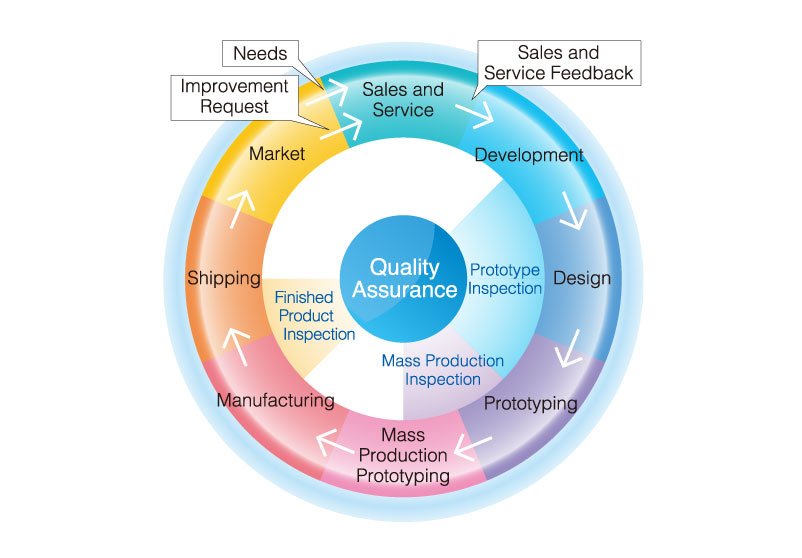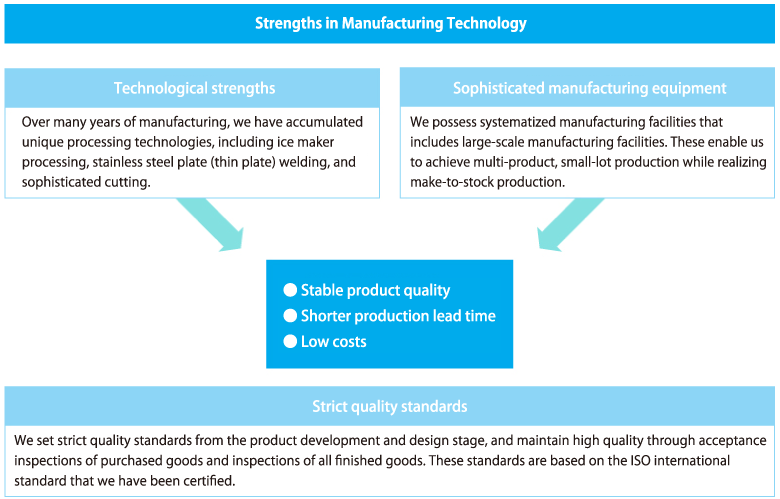Quality policy
We have clarified our intention to provide customers with peace of mind and are working on the maintenance and improvement of high quality.
- The provision of products that meet customer needs, regulations and other requirements
- Continuous improvement for an effective quality management system
- The achievement of quality targets based on the participation of all employees
The stable supply and quality control of products
We have obtained ISO 9001 certification, the international standard for quality, at all of our plants, clarified our intention to provide customers with peace of mind in our quality policy, and are working on the maintenance and improvement of high quality.
Based on our quality management system, we have built a system that carries out strict quality checks in all processes from the product development stage to manufacturing at the factory, inspection and shipment, and have built a production system to implement the stable supply of high-quality products.
Automatic ice makers are required to repeat operations within a temperature difference of nearly 50°C to produce ice about every 30 minutes by injecting room temperature water of about 20°C and cooling it to around minus 25°C in a cooling unit.
In addition, in kitchens, at the same time as requiring equipment that can withstand high temperatures and high humidity, it must not break down because it is equipment related to food products for which freshness control is important.
At Hoshizaki, we set strict quality standards based on the assumption that our products will be used in such environments, repeat experiments under severe conditions in our test laboratories, and adopt only those technologies and parts that pass our tests.
We have built a system under which strict inspections are carried out on finished products one-by-one, and only those that have passed the final inspection are shipped and delivered to customers.
Quality assurance
The Hoshizaki Group has built a mechanism that incorporates past defects and complaints into our quality assurance system.
When something is pointed out by a customer, we investigate the cause thoroughly and contact the design department immediately to reflect the information in new product development and improvements.
Links Between Product Development and Quality Assurance

Technical capabilities and advanced production facilities
Hoshizaki maintains advanced technologies that other companies do not have, such as sheet-metal processing, foaming, welding and cutting technologies that we have cultivated through our manufacturing activities over many years.
In addition, systematized manufacturing facilities, including large-scale manufacturing equipment, have been introduced to build a manufacturing system capable of producing a wide variety of products in small lots to meet the diverse request of customers.
We use such strengths in manufacturing technology to realize the stabilization of product quality, the shortening of production lead times and lower costs.
At the time of a model change or when producing a new product, we make sure to prepare product designs and equipment (poka-yoke mistake-proofing) to prevent mistakes due to human factors from occurring and comply with standard operations based on work instruction manuals so that we do not supply defective products to customers.
We educate workers on how to use tools and provide thorough guidance so that they perform work correctly based on work manuals to prevent mistakes on production lines.

Global collaboration
The Global Manufacturing Department holds regular meetings with each overseas plant to confirm the status of quality and conduct activities to assist with quality improvement.
Acceptance of customer audits
Each year, we accept audits by major restaurant chains, food and beverage manufacturers, and other customers at our manufacturing bases in Japan and overseas.
These have also led to the improvement of initiatives within the Hoshizaki Group in recent years as audit items from the BCP and ESG perspectives have also been wide-ranging, including the prevention of employee fraud, proper management of work hours, occupational safety and health, child labor and human rights, and preparations to ensure employee safety in the event of a disaster, not just product quality.


